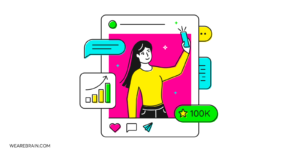Developing and executing an e-commerce marketing strategy: Part II

If you are thinking about starting your own e-commerce business, we think you would find our guide very useful: How to start your e-commerce business from scratch.
Welcome to the second article in our e-commerce marketing series. In this article, we will cover the most important e-commerce marketing channels and their respective best practices to drive traffic and conversions to your online store.
If you haven’t yet read Part I, which details the crucial elements of the preliminary planning and development phase for your e-commerce marketing strategy (including identifying vision, goals, objectives, and KPIs), then we suggest doing so before diving into the execution phase.
Without further ado, let’s jump into it!
Plan first, then execute
Now that you have a clearly defined roadmap to your business objectives based on your vision and mission statements, goals and objectives, and various KPIs to keep you aligned to these goals, you can begin to put your e-commerce marketing strategy into practice. It is important to remember your overall objective in this regard: to utilise various digital marketing tools and channels to raise awareness and drive action to your online business to sell more products.
Here are a few tips on how to do just that:
1. Social media marketing
Developing a robust online presence for your e-commerce business is crucial in driving brand awareness and cultivating an audience of directly engaged customers. The most powerful way to achieve this is through a strong social media presence that links directly to your e-commerce platform. Social media is a powerful tool to hook and engage online shoppers through its strong visual elements which are perfectly suited to presenting your brand and products in ways that ignite interest instantly.
Major social media networks (Instagram, Facebook, TikTok, etc.) are shifting towards in-platform purchasing which has seen a recent explosion of social shopping where users can discover, select, and purchase items in a few swipes. Be sure to leverage the alluring nature of shoppable content to make purchasing from your business easier.
Influencer marketing and live shopping are ways to leverage the pre-established trust and recognition of ‘celebrities’ on social media platforms to raise brand awareness and funnel sales to your e-commerce platform.
Paid social media advertising is always a good bet to get your products seen by your target audience. The major social media platforms have many tools and features marketers are able to utilise to get their campaigns seen by a wider audience.
2. Content marketing
The purpose of content marketing is two-fold: to create content that serves to improve your site’s search engine ranking, and to provide your customers with valuable and relevant content with the goal of trying to move them into the consideration stage to the conversion stage. This means creating content that lives on your site, primarily in the form of blog posts or videos.
Content marketing is built upon the idea of forming a strong relationship with your audience by providing value to their lives through the content you present. So, try to create as much valuable content as possible to cast your net wide to attract a large audience. You can do this by optimising your product page with concise, keyword-heavy copy, and write regular blog posts and articles that specifically add relevant value to your customers.
3. Search engine marketing (SEM)
Considerably relevant to all types of e-commerce businesses, search engine marketing (SEM) is a powerful tool to attract customers to your site. SEM involves search engine optimisation (SEO) and search engine advertising (SEA) – paid advertising.
You can boost your SEO game to optimise your content by understanding Google’s ranking algorithms. Getting your products ranked higher than your competition is key to staying ahead. But a more robust way to get your content seen by more people is through SEM powerhouse tools such as pay-per-click (PPC) campaigns, display ad campaigns, and product campaigns which allow you to feature higher in search engine results if you are prepared to spend money on paid advertising.
If your budget isn’t as formidable as your major competitors, there are other ways to improve your visibility online. Try to constantly optimise all of your e-commerce pages to improve findability, such as optimising for voice search.
4. Email marketing
Despite not being considered particularly fresh and glamorous, email marketing campaigns consistently prove to deliver a strong return on investment when done right. Taking a strategic and thoughtful approach to developing an engaging and valuable messaging will yield positive results.
Email marketing has come a long way in recent years with a major draw being the ability to automate campaigns. By segmenting your audience into specific groups according to their interests and purchasing history, you are able to set up and automate drip campaigns that aim to pique the interests of your audience to entice them to shop on your platform. Newsletters, promotions, discounts, and follow-up messaging can be highly effective to retain the attention of your customers and to entice them to make another purchase. There are a host of tricks to employ to get your email marketing game relevant and persuasive to your customers.
5. Affiliate marketing
Affiliate marketing is a rapidly growing sector that is generating high profit for e-commerce businesses. It involves a third-party (affiliate) promoting and selling your products for a commission: it’s like having an outsourced marketing team at your disposal.
Affiliate marketers often use traditional marketing methods to attract new customers, such as paid advertising and content marketing to either drive traffic to your site, or to promote and sell your product on their own site for a commission. Both options are beneficial for most e-commerce businesses: you gain increased traffic to your site or increase sales, or both.
6. User-generated content (UGC)
The beauty about this marketing channel is that it involves your customers actively promoting and marketing your products for you, for free. Not only does this drive more traffic to your site, it also brings a new batch of authentic followers who are genuinely interested in your products and brand.
Competitions and review platforms are great ways to drive your UGC, as having customers review and promote your products not only adds to your digital content initiatives, it also opens up dialogue and discussions which grows organic content for your business. People who otherwise may not have heard about your products will be introduced to them through UGC initiatives which give your business a wider scope of new leads.
7. Offline marketing
Just because your business operates in the digital ether doesn’t mean that traditional offline marketing tactics have no value. Instead, by combining both digital and traditional marketing efforts you are able to create a complete, all-encompassing marketing strategy which will get your brand seen and heard by a wider audience.
Offline marketing is a powerful and proven tool to promote your brand: think of radio, television, publications, and even live events have been promoting the largest global brands for years and there is lucrative merit embedded into this legacy. Of course, experiential marketing initiatives (events, launches, pop-up stores, etc.) are unfortunately on the back burner until this pesky virus abates. But when the post-pandemic dust settles for good, be sure to be the first to hit the ground running with these powerful traditional marketing tactics.
Quick tip: For more information to help get your e-commerce marketing planning and execution off to a flying start, be sure to read our article detailing the top digital marketing trends for 2023. You may find a few new trends useful to add to your strategy.
Summary
There you have it, our guide to executing your e-commerce marketing strategy to help boost traffic and conversions to your platform. Social media marketing, content marketing, search engine marketing, email marketing, affiliate marketing, user-generated content, and offline marketing are proven ways to increase brand awareness across the digital ether to establish strong connections with current and potential customers.
The first part of your e-commerce marketing strategy must cover the planning and preparation phase, and only once you have that are you able to begin rolling out the execution of your tangible marketing efforts. If you incorporate most or all of what we have covered then you will be well on your way to enjoying a thoroughly active checkout page. Good luck!
Get in touch
Do you require any assistance setting up your e-commerce platform and marketing strategy? Contact us today to see how WeAreBrain can help you create a successful e-commerce enterprise.
Paula Ferrai
Working Machines
An executive’s guide to AI and Intelligent Automation. Working Machines takes a look at how the renewed vigour for the development of Artificial Intelligence and Intelligent Automation technology has begun to change how businesses operate.







